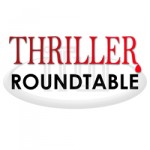

June 18 – 24: “Do thrillers always need to play on a large canvas, or can an intimate story thrill?”
 This week, join ITW Members Joseph Amiel, Eyre Price, Vincent Zandri, Bob Mayer, Annie Hauxwell, Jean Harrington and Pamela Callow as they discuss whether thrillers always need to play out on a large canvas, or if an intimate story can deliver the same thrills.
This week, join ITW Members Joseph Amiel, Eyre Price, Vincent Zandri, Bob Mayer, Annie Hauxwell, Jean Harrington and Pamela Callow as they discuss whether thrillers always need to play out on a large canvas, or if an intimate story can deliver the same thrills.
~~~~~
 Annie Hauxwell was born in London, the setting for her debut novel IN HER BLOOD. She has worked as a cleaner, cab driver, sociologist, psychiatric nurse and lawyer. She abandoned the law for a career as an investigator, combining this with screenwriting.
Annie Hauxwell was born in London, the setting for her debut novel IN HER BLOOD. She has worked as a cleaner, cab driver, sociologist, psychiatric nurse and lawyer. She abandoned the law for a career as an investigator, combining this with screenwriting.
 A member of the Nova Scotia bar, Pamela Callow is the internationally published author of the Kate Lange legal thriller series for MIRA Books. Her critically-acclaimed series has been compared to works by Robin Cook, Tess Gerritsen and John Grisham. TATTOOED, the third book of the series, releases on May 29th, 2012. Prior to making writing a career, Pamela worked as a Strategic Services manager for international consulting firm Accenture.
A member of the Nova Scotia bar, Pamela Callow is the internationally published author of the Kate Lange legal thriller series for MIRA Books. Her critically-acclaimed series has been compared to works by Robin Cook, Tess Gerritsen and John Grisham. TATTOOED, the third book of the series, releases on May 29th, 2012. Prior to making writing a career, Pamela worked as a Strategic Services manager for international consulting firm Accenture.
 Jean Harrington lives in Naples, Florida with husband John (no cat, no dog, no kids anymore). After teaching English lit at Becker College in Worcester, Massachusetts for 17 years, she now spends her days writing and loving every minute of it. Jean’s published works have won several RWA contests. DESIGNED FOR DEATH is the first in her Murders by Design Mysteries, and she’s having great fun wallowing knee deep in fictional dead bodies.
Jean Harrington lives in Naples, Florida with husband John (no cat, no dog, no kids anymore). After teaching English lit at Becker College in Worcester, Massachusetts for 17 years, she now spends her days writing and loving every minute of it. Jean’s published works have won several RWA contests. DESIGNED FOR DEATH is the first in her Murders by Design Mysteries, and she’s having great fun wallowing knee deep in fictional dead bodies.
 Vincent Zandri is the No. 1 International Bestselling Amazon author of THE INNOCENT, GODCHILD, THE REMAINS, MOONLIGHT FALLS, CONCRETE PEARL, MOONLIGHT RISES, SCREAM CATCHER, BLUE MOONLIGHT and MURDER BY MOONLIGHT. He is also the author of the Amazon bestselling digital shorts, PATHOLOGICAL, TRUE STORIES and MOONLIGHT MAFIA. Zandri’s list of publishers include Delacorte, Dell, StoneHouse Ink, StoneGate Ink and Thomas & Mercer. An MFA in Writing graduate of Vermont College, Zandri’s work is translated into many languages including the Dutch, Russian, and Japanese. An adventurer, foreign correspondent, and freelance photo-journalist for RT, GlobalSpec, IBTimes and more, he lives in Albany, New York.
Vincent Zandri is the No. 1 International Bestselling Amazon author of THE INNOCENT, GODCHILD, THE REMAINS, MOONLIGHT FALLS, CONCRETE PEARL, MOONLIGHT RISES, SCREAM CATCHER, BLUE MOONLIGHT and MURDER BY MOONLIGHT. He is also the author of the Amazon bestselling digital shorts, PATHOLOGICAL, TRUE STORIES and MOONLIGHT MAFIA. Zandri’s list of publishers include Delacorte, Dell, StoneHouse Ink, StoneGate Ink and Thomas & Mercer. An MFA in Writing graduate of Vermont College, Zandri’s work is translated into many languages including the Dutch, Russian, and Japanese. An adventurer, foreign correspondent, and freelance photo-journalist for RT, GlobalSpec, IBTimes and more, he lives in Albany, New York.
 NY Times bestselling author Bob Mayer has over 50 books published. Bob graduated from West Point and served in the military as a Special Forces A-Team leader and a teacher at the JFK Special Warfare Center & School. He is the CEO of Cool Gus Publishing, which has grown to a seven figure business in just two years, and is one of the bestselling indie authors in the US. For more see www.bobmayer.org or www.CoolGus.com
NY Times bestselling author Bob Mayer has over 50 books published. Bob graduated from West Point and served in the military as a Special Forces A-Team leader and a teacher at the JFK Special Warfare Center & School. He is the CEO of Cool Gus Publishing, which has grown to a seven figure business in just two years, and is one of the bestselling indie authors in the US. For more see www.bobmayer.org or www.CoolGus.com
 Joseph Amiel is an internationally best-selling author, whose novels include STAR TIME, BIRTHRIGHT, DEEDS, HAWKS and A QUESTION OF PROOF. He has also won awards for screenwriting and for his comedy-mystery web series Ain’t That Life. A graduate of Amherst College and Yale Law School, he is married and lives in New York City.
Joseph Amiel is an internationally best-selling author, whose novels include STAR TIME, BIRTHRIGHT, DEEDS, HAWKS and A QUESTION OF PROOF. He has also won awards for screenwriting and for his comedy-mystery web series Ain’t That Life. A graduate of Amherst College and Yale Law School, he is married and lives in New York City.
 Eyre Price was raised in Northeastern Pennsylvania, but has called a lot of places “Home.” A litigator for 15 years, Eyre left the law to become a stay-at-home dad–and write. His debut novel, BLUES HIGHWAY BLUES, will be published by Thomas & Mercer in June 2012. He has traveled the Blues Highway from Minnesota to Louisiana and stood at Robert Johnson’s fabled crossroads. He lives in Illinois with his wife and son.
Eyre Price was raised in Northeastern Pennsylvania, but has called a lot of places “Home.” A litigator for 15 years, Eyre left the law to become a stay-at-home dad–and write. His debut novel, BLUES HIGHWAY BLUES, will be published by Thomas & Mercer in June 2012. He has traveled the Blues Highway from Minnesota to Louisiana and stood at Robert Johnson’s fabled crossroads. He lives in Illinois with his wife and son.
- LAST GIRL MISSING with K.L. Murphy - July 25, 2024
- CHILD OF DUST with Yigal Zur - July 25, 2024
- THE RAVENWOOD CONSPIRACY with Michael Siverling - July 19, 2024
